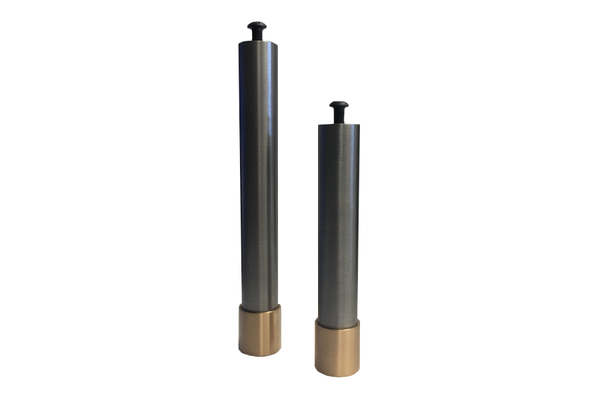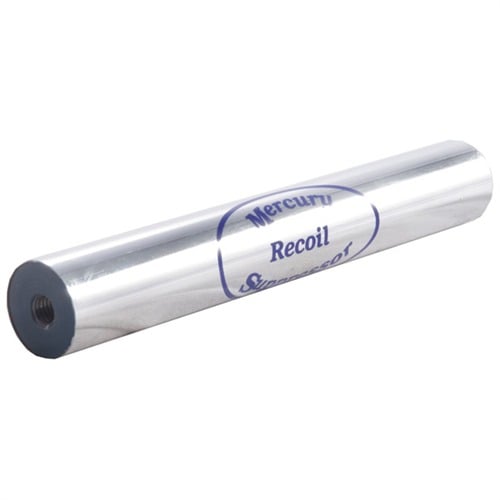maybe a bi metal weight ? back half /front half ? or brass and nylon plus small buffer port ?
Upvote 0
what about the length of travel ? shorten the travel to the stop point ? heaver weight /shorter travel ? might = more weight less impact = no deformation ? ?Yeah that has become my thinking as well. I think the key in my case will likely be a steel weight and a very, very small bleeder hole in the front so that it can create a momentary cushion. The brass weight, even with a soft buffer, ended up deforming after 50 shots or so.
Thats kind of the great part. It's just Newtons 1st law of motion. On object at rest remains at rest until acted upon by an external force. The weight, not being attached to the top hat aside from some slight side friction, will remain in place when the piston is fired. It's not until the rear of the top hat catches it that it starts to move forward. Seeing as to how you typically cock the gun vertically, the weight drops into position every time you load the gun. I should note that while changing the front port to a smaller size, the rear port could remain a bit larger.if like a port only allows so much to pass through and then I think you will need a light spring to return it after the shot cycle.
just wondering where in the stock they drilled the hole.. seems like it won't affect the stock or looks if it could be drilled behind the but pad..I bought a HW 97 from Steven Hanson ....back around 2000?
He had a mercury recoil reducer installed at the butt stock. It was drilled at an angle and epoxied in place.
I don't remember how it grouped. It was a blue laminate stock...There were issues with the blue laminate stock de-laminating and I finally junked it and switched to a regular beech stock. Never salvage the mercury recoil reducer as I didn't feel like drilling a hole in the new stock.
It looks like someone is still making and selling these mercury recoil reducers for shotguns?
MERCURY RECOIL SUPPRESSORS, RECOIL REDUCTION, REDUCE RECOIL IN SHOTGUNS AND RIFLES
MERCURY RECOIL SUPPRESSORS, RECOIL REDUCTION, REDUCE RECOIL IN SHOTGUNS AND RIFLESwww.mercuryrecoil.com
I know this is slightly off topic. Was wondering if anyone had experience with these type of recoil reducing system.
I'm assuming that it didn't help much ...since none of us are rushing out there to buy one an drill holes in our stocks.
Yup behind the butt pad. (or in front of the butt pad)just wondering where in the stock they drilled the hole.. seems like it won't affect the stock or looks if it could be drilled behind the but pad..
Mark
so if you made a fixture to hold it in a drill press you could remove the but plate and drill it and it wouldn't matter if it was in or not because there would be no visible alterations to the visible part of the stock..


Recoil is a combination of mass and speed. Larger guns with more mass and stronger spring speeds will have the most recoil. There's no real way around it. Reducing speed or weight reduces recoil. It also reduces power. Lightweight pistons reduce weight but increase speed and invite excessive piston bounce which reduces efficiency (power).I'm also curious about the relationship between the caliber and the bore of the cylinder.. and well length of stroke will be a factor.. too short of stroke I think will result in less power and too long of stroke the pellet will leave the barrel and then the piston will slam the end same as dry firing..
it very interesting to learn how everything works together..
Mark
You had it right the first time. Its about reducing recoil with too light of a hat that would normally give some bounce, but mitigating that bounce by having the top hat change weight when it needs too (more or less). I think bounce has taken over the conversation a bit more because really that is the hardest part to figure out hereAlthough it seems like this thread was initially about reducing recoil it was really about reducing piston bounce.
I have to think about this. Recoil energy is basically mass and speed. Including a sliding weight doesn't necessarily remove all its mass from the equation. It may reduce felt recoil by dampening piston bounce and spreading recoil energy more evenly. Certainly a good thing that could improve efficiency and accuracy. I'm not sure if it would actually decrease overall recoil energy.You had it right the first time. Its about reducing recoil with too light of a hat that would normally give some bounce, but mitigating that bounce by having the top hat change weight when it needs too (more or less). I think bounce has taken over the conversation a bit more because really that is the hardest part to figure out here
spring most likely would introduce a whole 'nother problem . finding a spring the has the right dimension's and force ? Besides it was talked about already as you would cock the gun in an upright position and the weight would just fall back due to gravity .What about spring loaded to control the weights sliding / dampening spring ? Then that could help relieve the weight slamming at the end of travel ?